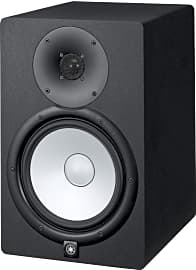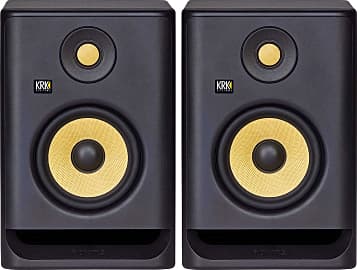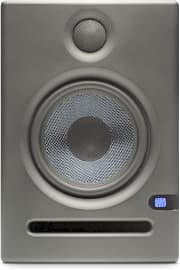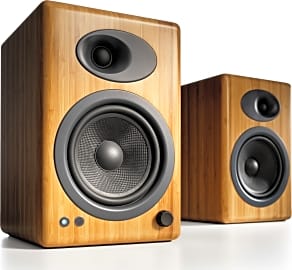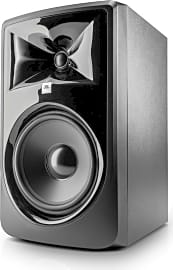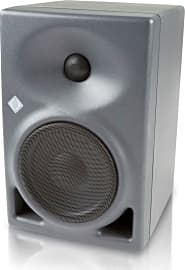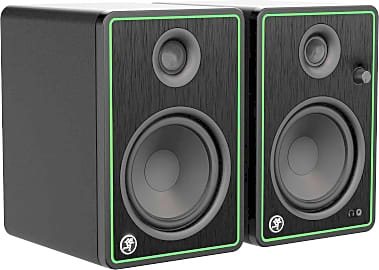The 9 Best Active Studio Monitors

This wiki has been updated 38 times since it was first published in June of 2015. Whether you're outfitting a professional recording studio or just trying to maximize the quality of your home stereo system, a pair of high-quality powered studio monitors can be indispensable. They tend toward a flat frequency response, allowing you to hear your favorite music as the artist intended, or to mix your own tunes to perfection. Our list includes options for every budget. When users buy our independently chosen editorial choices, we may earn commissions to help fund the Wiki.
Editor's Notes
February 18, 2021:
We thought it wise to remove the ultra-high-end Focal Twin6 Be from our recommendations, in part because of its high price. At that kind of investment level, you'd be better served to investigate the speakers fully in person and compare them to other ultra-expensive models. We also dropped the M-Audio AV42 because it's no longer part of the company's active product line, and its closest replacement is outperformed by other options at similar prices.
In particular, if your space is relatively large and you want the best, the Yamaha HS8 and Adam Audio A7X are both good places to start. The KRK Rokit series and everything related to the PreSonus Eris E5 are excellent mid-range options, and the Behringer B2031A costs just a little more, but comes with the reliable Behringer reputation as well as a premium cast-aluminum chassis. Our newest addition to the ranks, the Mackie CR-X Series, is about as cheap as many producers will be comfortable with, although as long as you properly treat it for noise and ground loops, it should work well and with minimal interference.
December 19, 2019:
First of all, you should be aware that even the best studio monitors will perform poorly without proper acoustic treatment, and faulty, low-quality, or mismatched cables can be dangerous, so good cables are important as well. Also, these are near-field monitors and generally bottom out around 50 hertz, so if you want to recreate sounds below that, you may want to consider a near-field subwoofer also. If all this sounds daunting, or if you just want an alternative to a good set of monitor speakers, it's also worth considering a pair of studio headphones, which many professionals swear by.
With that out of the way, there's one primary consideration among all the fancy terminology and confusing specifications. A monitor's sound profile should be relatively flat and the unit should allow for minor adjustments to account for the differences between individual studios. The Adam Audio A7X is great on both counts, and it comes highly recommended by producers from many genres. The Neumann KH 120 is similarly lauded and offers even more nuanced control of high- and low-frequency exclusion. They're both pretty costly, but they're actually pretty much in line with what you can expect to pay for high-end monitors. Focal Twin6 Be is even more expensive, but if you insist on the best, it's a good place to start looking.
In a slightly more affordable group are the JBL 308P MkII, Yamaha HS8, and KRK Rokit 5. These are all extremely popular among electronic and hip-hop producers. Some say that the KRKs feature slightly elevated bass and treble, which some people prefer while mixing, but not everyone. The Yamaha is a larger version of the company's popular HS5 just like the JBL is the larger relative of a popular older model. Quite a few users will probably be satisfied by any of these options.
The PreSonus Eris E5 and Behringer B2031A are both surprisingly high-performing in light of their price, and even though they're inexpensive, they're excellent monitors -- again, provided you have a properly treated space to use them in. And the Audioengine A5+ are great for multipurpose home studios, as they're essentially souped-up bookshelf loudspeakers and sound great at both low and high volume.
Special Honors
Genelec 8010A Normally we recommend finding the biggest speakers that will reasonably fit your space, so if that space is tiny, these ultra-compact Genelecs may be your best bet. They're surprisingly powerful for such a small pair and suitable for various uses in addition to recording and mastering. genelec.com
Unity Audio The Rock MkIII A number of advanced features help this 2-way monitor really shine. Unlike most, it's a sealed-cabinet design, and it's made from high-quality birch wood that provides top-of-the-line resonance. It boasts a highly refined tweeter that can make sounds as high as 50 hertz. unityaudioproducts.co.uk
DynAudio LYD 48 If you want to make absolutely certain you're putting the right amount of bass in your new dubstep masterpiece, check out this three-way beauty with a built-in subwoofer. In addition to advanced technological design, it's built with absolutely premium materials, resulting in a signal path that can pass 24-bit, 96kHz audio with zero degradation. dynaudio.com
The Importance Of Quality Sound In Your Studio
In the early stages of personal recording, sound quality was a nightmare.
Having high quality sound in the home studio can mean the difference between the success and failure of any musical venture. In the early stages of personal recording, sound quality was a nightmare. Old reel-to-reel tape recorders produced only low quality recordings, and each reel could only be used once. The home studio of the time usually consisted of a reel-to-reel recorder and as many reels as the artist could afford. Even in the quietest rooms with no added noise, the quality was poor.
Artists today have no such issue. Recording is all done digitally, with little room for error. Even acoustic music is patched through pickups before reaching the recording software. Many takes of the same piece can be recorded until the ideal performance is realized. High quality recordings can be created just about anywhere now. Unfortunately for recording artists, this is a bit of a double-edged sword. While it is easier than ever to create high quality recordings, anything other than perfect sound quality is quickly disregarded by listeners. Many years ago, listeners were used to recordings with poor sound quality and would not immediately dismiss an artists just because the recording was low quality.
A successful artist must pair this recording capability with an effective way to monitor changes in the sound they are creating. The capabilities of simple computer speakers are severely limited. These speakers do not have the same playback range as active studio monitors, and the end product will suffer if this is all the artist uses for reference. To achieve the highest quality sound, the best tools need to be used from start to finish.
How The Speaker Changed The Record Label
Thanks to the creation of the modern speaker, radio waves can be harnessed and delivered to homes across America. Big band crooners of the 1930s and 40s ushered in a new era in the music industry. Singers like Frank Sinatra enjoyed popularity with adolescent girls of the day. This movement sparked new thoughts in the minds of record companies; who until this point had catered mostly to adult audiences. For the first time in history, pop trends were being steered by children rather than adults. The large record companies took control of these trends to grow their bank accounts balances.
Big band crooners of the 1930s and 40s ushered in a new era in the music industry.
Rather than simply being sold a record they could listen to; these adolescents were now also being sold on the experience of the pop icons themselves. From the clothing the artist wore to the way they acted and styled their hair; even the types of songs they sang were chosen to increase the star's popularity with a younger audience. This process was directly influenced by the record label supporting the artist; and conveniently benefited the large record company more than anyone else. Artists were held to these conditions by their contracts. Should a musician not like the terms of the agreement, they had to either wait out the contract or suffer the consequences of breaking it.
As the record labels are set up to make the most money from complicated recording contracts, it stands to reason that this is still the current state of the popular music industry. The main focus of the mass culture is not in seeing the live performance of the recording artists; it is in the collection of a large library of records which can be played back on demand at any time.
Evolution of the Speaker
The first amplifying speakers were not actually speakers at all; they were horns. The horns were able to amplify sound waves created by the needles of record players; though not by much. As the needles dragged across the record's surface, minute variations caused the needle to vibrate. This needle would then vibrate a metal diaphragm; pulsing air into the lower end of the horn to create sound. The sound was then channeled through the horn, resonating and reverberating along its walls to amplify the sound to an acceptable level for normal use around the house.
This needle would then vibrate a metal diaphragm; pulsing air into the lower end of the horn to create sound.
This limited amplification was relatively short lived. In the 1920s, the first electrodynamic speaker was introduced. Electrodynamic speakers use an electromagnet and a diaphragm to create sound. The electromagnet senses electric signals; turning them into tiny movements. A copper wire surrounding the electromagnet moves in response to the magnet. These movements are then transferred to a cone diaphragm, which vibrates accordingly, expanding the sound as it travels outward.
To invent a seemingly simple speaker, one must understand sound waves, radio, electricity, physics, and chemistry. This is why it took until the 20th century to invent an object which now seems quite common. These speakers remain the standard to this day, though with many enhancements.
One such improvement is in the invention of flat panel speakers. Looking for ways to decrease the size of a speaker box, engineers thought up the flat panel speaker. It is made of a small electromagnetic exciter which vibrates a large rectangular membrane that acts as both diaphragm and resonator. This simple style choice can make a drastic difference in size. Inventors are still having difficulty vibrating the entire flat surface area while also allowing for good frequency response, which is why they have yet to see much success in the market.


